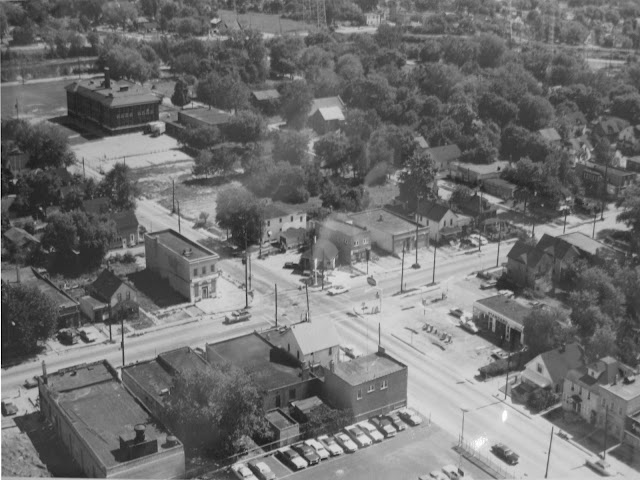
Reviewed by Sherrema A. Oom-Dove
The Saints of St. John Street, written by Executive Director and resident playwright Charles H. Winfrey, is semi-autobiographical. Directed by McCree veteran Patricia Enright, the play is set in 1955 and the hapless schoolboys of the Saints baseball team are despondent at yet another loss, but remain hopeful of finding a coach. However, their innocence is shattered when a 14-year-old boy from Chicago is lynched in Money, Mississippi. He is Black, his murderers are white, and this horrific happening in U.S. history resonates all the way to St. John Street in Flint, Michigan.
The production opens with four boys named Stick (Josiah Grays), Leedell (Nathaniel Leonard), Kilboy (Javonte Booth), and Peewee (Christian Berry), who sit on the front porch of Stick’s home, near the corner of St. John and Leith Streets, and discuss baseball, Fairview Elementary School, the Columbia movie theatre, and music. When the neighborhood ne’er-do-well, Pawn Shop Shorty (Ulysses ‘BT’ Bailey) saunters past, he creates a ruckus. The boys begin to repeat things they have heard their parents and other adults say about the ‘old man.’ He is not unlike the character of Bad Leg in the book, entitled American Street by Ibi Zoboi, who has spent a lifetime sitting on the corner of American Street and Joy Road in Detroit. He absorbs the mistrust, secret fears, and bullying of others while never relinquishing his place. He is a constant in a small cosmos that is constantly changing.
When their daily life is disrupted by radio reports of the death of Emmett Till at the lynching hands of white men, St. John Street residents, young and old, viscerally feel his loss. Although Mississippi is far away in the American Deep South, the realities of life for Black people, even in the North, brings the truth of unbridled racism home. Twelve-year-old Esther (Jenna Sweet) has had enough of watching the baseball boys go where they please and finally leaves the safety of her front yard to join them, only to come up missing. When a racist white police officer (Lennie Brousseau) shows up to investigate Esther’s disappearance, he instills little hope in the family and their neighbors, and her grief-stricken mother Lucy (Alina Oliver) becomes a proxy for Mamie Till. Although Lucy organizes a search party and the play comes to a satisfying conclusion, the underlying tension brings home the truth that many Northern and Southern whites meet in their mean-spirited prejudice and Blacks are left feeling isolated and without true citizenship.
In Saints, Stick (Grays) and Leedell (Leonard) are natural leaders and as the play unfolds, their characters deepen with understanding about the world around them. Stick performs a spontaneous rendition of ‘Why Do Fools Fall in Love,’ while Leedell demonstrates the common phrase of being apprehended when ‘walking while Black.’ Kilboy (Booth) and Peewee (Berry) hold their own as friends and fellow teammates who listen and contribute to the boys’ banter and adventures. When they ask Jomo (Clifford Sykes), Stick’s father, to coach their team, Jomo immediately begins by laying out a three-point plan and calls for team practice the same day. He quickly sees that his work is cut out for him.
Next door are Esther and older sister Willie Bell (Surenity Boone), with Friend (Lavae Thompson), and they provide gender juxtaposition as they play with dolls, talk coyly about the boys, and remain close to home. The girls’ mother Lucy, beautifully and dramatically played by Oliver, is the center of family life on St. John Street. Her husband and daughters’ father Roscoe (Gene Bowen) is employed at ‘The Buick’ when GM denies feeding chemicals to the Flint River, defends his position to Jomo. The two nearly come to blows in an argument that thunders down the annals of Flint history to the present day. Jomo’s wife Anna Pearl (Shyran Thompson) is a quiet source of support to her family. Their teenage daughter Alma (Za’nayjah Johnson) is dating ‘Bum Beatle,’ also called Jerome (Navarrio Harper). He is socially conscious, having conversation with Jomo about W.E.B. Du Bois’s The Souls of Black Folk, proves himself to be a good match. Clara Mae (Martra’ Roberts) ably portrays the neighborhood spiritual whose unshakeable devotion to God makes her a holy eccentric. Her opposite, Slap-God-Almighty (Michelle Bryant), boldly stands up to the racist police officer and their juxtaposition seems to represent justice as a spiritual practice. Cleo (Alverine Simpson) provides comic relief as a transgender character.
McCree costumer and Marketing Director, Pat Y. Hill, is known for her elegant and intricate costume designs. However, she said, the simplicity of the clothing in Saints presented challenges in accurately portraying residents of a working-class, 1950s neighborhood in Flint. The costumes are offset by wigs and cosmetics artfully arranged by Sharon Butler. The set (Al Foster and Reggie Bingham) was beautifully constructed and designed as one section of St. John Street, representing two homes and a pawn shop. Yet, the play’s rich dialogue helps portray the broad array of daily life, complete with shops, trades, churches, and places of entertainment. Sound (Kathy ‘Tess’ White) and lights (Eric Williams) appropriately provide audio and illumination to the set.
Finally, no Charles H. Winfrey production is complete without his signature setting of music, and in “Saints,” The Calvacades – consisting of McCree veterans Phillip Young, Chris Young, Johnny Person, and Fred Fife – set the tone. Standing on the corner at Leith and St. John Streets, they sing about the vibrant life of a community that is now 50 years gone but still lives on in the heart, soul, and memory of Flint residents.
The Saints of St. John Street continues its run through February 24th, 2024 at The “New” McCree Theatre. For tickets, go to their website at https://www.thenewmccreetheatre.com/product/the-saints-of-saint-johns-street
Background History Highlights about Flint’s St. John Street Neighborhood
According to Michael W. Evanoff, author of St. John Street: Through the Melting Pot (1989, 4th Ed., pp. 1-4, 322-25), St. John Street first appeared in an 1874 Flint city directory. The first plat was recorded in October 1907 and named ‘Fairview’ because the original regional land, inhabited by the Algonquin and Chippewa nations, was ‘fair to behold.’ With the establishment of Buick, adjacent to St. John Street, in 1908, the community reached maturity in 1925. Immigrants from Eastern European nations came to Flint to work at The Buick and other General Motors (GM) factories that sprang up across the city’s landscape. Assyrians, Bulgarians, Croats, Greeks, Hungarians, Macedonians (among which Evanoff and his family numbered), Poles, Serbians, and many other nationalities converged on the St. John Street neighborhood and built it into community. The International Institute of Flint was originally located at the same corner where Stick’s family resides in “Saints.”
In 1945, the demographic shifts brought by the end of the Great Depression and WWII found a changing population in the St. John Street neighborhood. European whites and their descendants moved out and American Black families, especially those who migrated from the Deep South for employment at GM, moved in. The community continued to thrive as a self-contained community where people lived, shopped, worshiped, and entertained. Still, the deterioration that began before 1945 continued. Historic houses and buildings were leveled by the wrecking ball and in the early 1970s, construction and completion of I-475 brought about the end of this history-rich community.
The reviewer’s paternal step-grandmother, from birth in December 1914, spent her girlhood, youth, and early married life in homes on Michigan Avenue and Dakota St., respectively, in the St. John Street Neighborhood. She attended Fairview Elementary.

St. John and Leigh Street. Photo is from Gary Godin’s blog: http://buickcity.blogspot.com/2008/04/st-jonh-industrial-park-urban-renewal.html

Pingback: Sherrema’s Reviews of Community Theatre Shows | Sherrema's Shenanigans